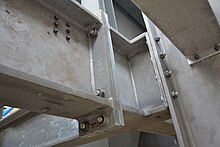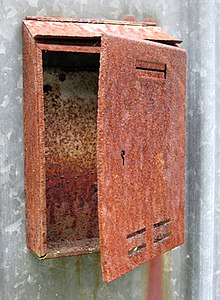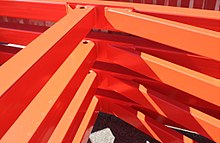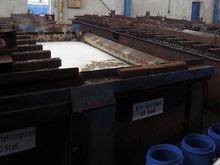Hot-dip galvanizing


The hot-dip galvanizing is a method for steel before corrosion protection (rust). Hot-dip galvanizing is the process of applying a metallic zinc coating to iron or steel by immersing it in molten zinc (at around 450 ° C). A resistant alloy layer of iron and zinc forms on the contact surface and a very firmly adhering pure zinc layer on top. Hot-dip galvanizing is one of several galvanizing methods . In the hot-dip galvanizing (discontinuous) between is galvanizing and (continuous) strip galvanizing distinguished. Both batch galvanizing and strip galvanizing are standardized processes. The batch galvanizing is regulated in DIN EN ISO 1461, the strip galvanizing of sheet metal in DIN EN 10143 and DIN EN 10346.
Strip-galvanized steel is a preliminary product (semi-finished product) which, after galvanizing, is further processed by forming, punching and cutting. This destroys the protective zinc layer on the cut and punched edges. In contrast to this, components protected by piece galvanizing, such as stair constructions, are first manufactured and then hot-dip galvanized. This means that the components are completely protected from corrosion. Piece galvanizing and strip galvanizing also differ in terms of the zinc layer thickness, which results in different protection periods. The zinc layer thickness of strip galvanized sheet metal is usually between 7 and 25 micrometers, the zinc layer thickness of individually galvanized steel parts is usually between 50 and 150 micrometers.
properties
The zinc layer is usually brightly shiny when fresh. Over time, as a result of the corrosion of the zinc, it develops a patina and becomes darker and duller in appearance. The patina is a weather-resistant protective layer made of zinc oxide and zinc carbonate. If the air and thus the carbon dioxide access is restricted, for example through improper packaging, storage or improper transport, the undesirable white rust occurs on freshly galvanized components .
Hot-dip galvanizing offers both active and passive protection against corrosion. Passive protection is provided by the barrier effect of the zinc coating. The active corrosion protection arises from the cathodic effect of the zinc coating: Compared to more noble metals such as iron (see voltage series ), zinc serves as a sacrificial anode , which protects the iron underneath from corrosion until it is completely corroded itself. The anodic effect also protects exposed areas of damage or non-galvanized cut edges up to a certain distance from the adjacent zinc surface. However, this accelerates corrosion and erosion of the adjacent zinc layer itself.
Depending on the thickness of the zinc coating, hot-dip galvanizing can have a different duration of protection. Zinc coatings produced in the batch galvanizing process are characterized by thicker zinc layers than zinc coatings produced in the strip galvanizing process, which in turn offer better corrosion protection than galvanically applied zinc layers. “Piece-galvanized” coatings therefore achieve decades of economical corrosion protection without maintenance. According to the table published by the German Federal Ministry of Transport, Building and Urban Development “Useful life of components for life cycle analysis of the Sustainable Building Assessment System (BNB)”, piece-galvanized components usually have a useful life of more than 50 years. Information on the duration of protection of hot-dip galvanized coatings in different corrosivity categories is also given in Table 2 of EN ISO 14713-1.
The duration of protection of hot-dip galvanizing can be further improved with an additional coat of paint (" duplex system ").
Recently, batch galvanizing has also been used for fire protection purposes. A research project at the Technical University of Munich, completed in 2019, has shown that hot-dip galvanizing improves the fire resistance of steel. The improvement in fire resistance is based on the reduced emissivity of hot-dip galvanized steels. This means that a fire protection period of 30 minutes is often possible with unprotected, hot-dip galvanized steel structures.
Piece galvanizing

Piece galvanizing according to DIN EN ISO 1461 is the hot-dip galvanizing of (mostly) larger steel parts and structures. Here, blanks or finished workpieces are individually dipped into the weld pool after pre-treatment. Diving also means that interior surfaces, weld seams and inaccessible areas are easily reached. Examples of piece galvanizing: crash barriers (guardrails), railings, external stairs, car trailers, truck trailers, parts for steel halls, steel-glass buildings and parking garages.
Process steps in batch galvanizing
The process steps described below are only an example. Deviations may occur depending on the respective operational conditions. In systems for hot-dip galvanizing of small parts, considerable changes in the process sequence can occur.
Preparatory work steps
Except in large industrial plants (e.g. body galvanizing), hot-dip galvanizing usually takes place in contract galvanizing plants. A rough surface preparation must have been carried out for this. The parts must be free of loose rust and old paint. Prior sandblasting may be required. Hollow profiles must be drilled (10 mm and larger). All liquids must be able to run out completely from these holes. Pointed inside corners should be rounded.
After the parts to be galvanized have been delivered to the hot-dip galvanizing plant and a necessary incoming inspection has been carried out, the workpieces are first assembled into batches of similar or similar components so that economical galvanizing is possible. The parts are weighed before or after. In the so-called black weighing (before galvanizing), a previously determined percentage is added as zinc acceptance. The resulting weight is then included in the calculation. With the so-called white weighing (after the galvanizing process), the final weight is multiplied by a fixed base price (according to a material-related tariff group). The product of weight and tariff group then results in the final invoice amount plus the applicable VAT.
There is usually no differential weighing.
Degreasing / rinsing
Parts with residues of fats and oils are cleaned in a degreasing bath. Aqueous alkaline or acidic degreasing agents are usually used as degreasing agents. An alkaline degreasing bath is followed by brief immersion in a water bath in order to prevent degreasing agents from being carried over with the items to be galvanized.
In the case of acid degreasing, dilute hydrochloric acid is usually used as the basis. There is no need to rinse after degreasing if hydrochloric acid is also used as the operating medium in the subsequent pickling process.
Pickling
The next step is a pickling treatment to remove specific impurities (e.g. rust and scale) from the steel surface. Pickling is usually done in dilute hydrochloric acid. The duration of the pickling process depends on the degree of rusting of the galvanized material and the working concentration of the pickle. The pickling baths are usually operated at room temperature, but bath temperatures of up to 40 ° C can also occur.
do the washing up
After pickling, two rinsing processes are carried out in water in order to minimize the carryover of acid and salt residues with the galvanized material as far as possible.
Pickling of galvanized parts
The zinc coating can be removed again after a faulty galvanization or after a design change on a galvanized part. For this, however, the pickling bath mentioned above must not be used, but a special pickling bath with dilute hydrochloric acid. This leads to a chemical reaction in which hydrogen ( ) is formed. This gas is bound in a foam film. Handling ignition sources should be avoided in the vicinity of this bath, as this could lead to an explosion. The de-galvanized parts are then fluxed and re-galvanized.
Flux
A flux bath follows the rinsing bath. The task of the flux is to carry out a final, intensive, ultra-fine cleaning of the steel surface during the reaction with the molten zinc and to dissolve the oxide skin of the zinc surface, as well as to briefly prevent renewed oxidation of the steel surface during the waiting time before the galvanizing process. Similar to soldered joints, for example, where flux is also used, the flux increases the wetting ability between the steel surface and the molten zinc. The flux mostly consists of an aqueous solution of chlorides , most often a mixture of zinc chloride (ZnCl 2 ) and ammonium chloride (NH 4 Cl) .
dry
In most cases a drying station follows, in which the flux film is dried with heat. In many hot-dip galvanizing plants, the waste heat from heating the galvanizing kettle is also used to heat degreasing baths and drying ovens. The only purpose of heating / drying the components is to evaporate adhering water (moisture) so that undesirable reactions (formation of water vapor) in the 450 ° C zinc are avoided. The components can be relaxed (avoiding thermal distortion) at the prevailing drying temperature of max. 90 ° C technically and physically not take place.
Galvanizing
After the flux treatment or drying, the items to be galvanized are dipped into the liquid zinc melt. Zinc has a melting temperature of about 419 ° C; The operating temperature of a galvanizing bath is in most companies between 440 and 460 ° C, in special cases even more than 530 ° C (high temperature galvanizing). According to DIN EN ISO 1461, the zinc content of the melt is at least 98.5%.
After the material to be galvanized has been dipped into the molten zinc, the parts remain in the zinc bath until they have reached its temperature. After the flux has now been “boiled off”, the surface of the zinc bath is cleaned of oxides and flux residues before the material to be galvanized is pulled out of the zinc melt.
During the galvanizing process, as a result of the mutual diffusion of the liquid zinc with the steel surface, a coating of variously composed iron-zinc alloy layers forms on the steel part. When the hot-dip galvanized objects are pulled out, a layer of zinc - also known as the pure zinc layer - remains adhering to the uppermost alloy layer, the composition of which corresponds to the zinc melt.
cooling down
The parts are cooled in the air or in a water bath.
Plastering or deburring
Now the slings or tie wires are removed and the resulting glue points are reworked in accordance with the standard. If there are non-galvanized areas on the components, these may be reworked within narrow limits and according to defined rules. The maximum permissible size per individual imperfection is 10 cm², with all imperfections on a component not exceeding 0.5% of the component surface as a whole. The rework can be done by spray galvanizing or by a zinc dust coating. Which of the aforementioned processes is used depends on the component and the technical conditions in the galvanizing plant.
In a final step, the finished galvanized material is weighed, as the galvanized weight is usually the basis for the company's price determination. The quality of the hot-dip galvanizing is checked before delivery. If necessary, the parts can be plastered, i.e. zinc tips and uncleanliness on the zinc coating are removed.
Post-treatment
The requirements for the appearance of hot-dip galvanizing are increasing. The freshly hot-dip galvanized surface should keep its shine for as long as possible and only slowly and evenly form white rust, thus preserving the high visual quality of the galvanizing for longer. These are post-treatments in the sense of DIN EN ISO 1461, March 1999 edition. “Zinc coatings applied to steel by hot-dip galvanizing (batch galvanizing); Requirements and tests ”and the national supplement I, which preserve the gloss of a freshly galvanized surface for longer and delay the formation of white rust. This extends the excellent quality impression of a freshly hot-dip galvanized surface, increases the value of the surface and reduces customer complaints that can be attributed to white rust and reduced gloss. Chromium-free, air-drying, water-soluble dip paints that can be applied in a dip application are advantageous. The post-treatments are usually also an excellent primer for a subsequent powder coating or wet painting.
Result
|
|
DIN EN ISO 1461 |
|---|---|
| Area | Corrosion protection |
| title | Zinc coatings applied to steel by hot-dip galvanizing (batch galvanizing) - requirements and tests |
| Latest edition | 2009-10 |
| ISO | 1461 |
An essential criterion for the quality of hot-dip galvanizing is the thickness of the zinc coating in µm (micrometers, one thousandth of a millimeter). In the standard EN ISO 1461 "Zinc coatings applied to steel by hot-dip galvanizing (piece galvanizing)" (previously standardized in Germany in the DIN standard DIN 50976), the minimum values of the required coating thicknesses are specified as they are to be delivered depending on the material thickness for piece galvanizing .
Minimum layer thickness of zinc coatings according to EN ISO 1461:
- Material thickness 0 to 1.5 mm: coating thickness> 45 µm
- Material thickness 1.5 to 3.0 mm: coating thickness> 55 µm
- Material thickness 3.0 to 6.0 mm: coating thickness> 70 µm
- Material thickness> 6.0 mm: coating thickness> 85 µm
In practice, the layer thicknesses are well above the minimum layer thicknesses specified in EN ISO 1461. As a rule, zinc coatings produced by batch galvanizing are 50 to 150 µm thick.
A mean minimum layer thickness of 50 μm is provided for fasteners regardless of the thread size.
Galvanizing of small parts
In the case of small steel parts, galvanizing is often too expensive. In this case, the small parts are placed in bulk in a metal basket and the metal basket is completely immersed in the molten zinc. There are the following differences compared to batch galvanizing:
- The bath temperature is set above 530 ° C.
- As an additional process step after galvanizing, the small parts are usually centrifuged by rotating the metal basket. One then speaks of slingshot.
- Centrifugation reduces the thickness of the zinc layer. The reduction of the zinc layer thickness is particularly important for parts with a thread or for parts with precise dimensional tolerances. Threads would often no longer work without centrifugation.
- The color of completely galvanized centrifugal goods is usually less brightly shiny than the color of individually galvanized parts, but rather gray. This is a result of centrifugation, because the pure zinc is thrown off the surface.
Examples for galvanizing small parts: screws, nuts and fasteners.
Economic importance of batch galvanizing
In Germany, batch galvanizing protects around 1.9 million tons of steel against corrosion every year. This corresponds to a turnover of approx. 700 million euros. Around 85 percent of the tonnage is refined on a subcontract basis. The customers of hot-dip galvanizing plants mainly include steel and metal construction companies, series parts manufacturers and the steel trade. Around half of the hot-dip galvanized tonnage is used in construction. Other important areas of application are industrial equipment, transport, vehicle construction, agriculture, road equipment, supply and disposal as well as small parts. Typical products are crash barriers, balcony railings, staircases with gratings, car trailers, truck trailers, steel structures (e.g. steel halls, modern steel-glass architecture, parking garages).
Continuous strip galvanizing (Sendzimir process)
Continuous strip galvanizing is also known as the Sendzimir process (named after Tadeusz Sendzimir ). Strip galvanizing lines combine the process of hot-dip galvanizing with that of annealing . They consist of an inlet zone, a treatment zone and a cooling zone.
The starting material is usually unannealed, cold-rolled steel strip (0.4 to 4 mm thick, 400 to 1800 mm wide) that is wound into a coil (bundle). The strip length of such a coil can be up to 3000 m. The steel strip is unwound from the coil in the entry section . Two decoilers and a welding machine enable the production of endless strips so that the system can be operated continuously.
The actual treatment part consists of the continuous furnace, the molten bath, a device for adjusting the zinc coating and cooling. In modern systems, the continuous furnace is usually preceded by a cleaning section that removes residues from cold rolling or anti-corrosion oil. The continuous furnace is divided into the directly heated preheating zone, the indirectly heated reduction and holding zones, and the cooling zone. In the preheating zone, the strip is quickly heated to around 450–650 ° C. This part is also called the oxidation zone. The strip was cleaned oxidatively , for example by burning off emulsion residues from cold rolling. In the reduction and holding zone, the strip is further heated in a reducing protective gas atmosphere ( forming gas : about 25 to 28% hydrogen in nitrogen ) to about 800 ° C. and kept at this temperature. The strip is continuously annealed , the desired mechanical properties of the base material being set through recrystallization of the steel. In addition, iron oxides formed in the preheating zone are reduced. The subsequent cooling zone is connected to the weld pool by a lock (trunk). In the cooling zone, the strip is cooled to a temperature close to the melt bath temperature under protective gas.
The strip dips diagonally downwards into the weld pool (bath temperature with zinc approx. 460 ° C), is deflected upwards by a roller in the bath and leaves the weld pool again. As it exits the bath, the strip pulls with it an amount of metal, which is dependent on the speed of the strip and which is far above the desired coating thickness ( layer ). The still liquid excess coating metal is wiped off on the front and back using a so-called nozzle wiping process with a directed air jet from a wide flat nozzle. The coating thickness that can be set and regulated in this way depends on the belt speed, the blow-off pressure and the nozzle distance from the belt ( see also: Electromagnetic belt stabilization ). The strip is then cooled by air jet coolers, the metallic coating solidifying on the strip surface. The resulting crystal structure and its appearance depend on the type of coating and the conditions of the solidification process.
If required, the hot-dip coated steel strip can be rolled ( skin-passed ), straightened and possibly chemically post-treated ( phosphated , passivated ) in the hot-dip galvanizing plant . The tape is then rewound into a coil.
The strip speeds in continuous hot-dip galvanizing plants are up to 220 m / min, depending on the strip thickness, so hot-dip galvanizing plants achieve a ton output of over 2000 t of galvanized steel strip per day. From the time the strip is heated up to the point when the strip is immersed in the liquid zinc , care must be taken that not the slightest traces of oxygen get onto the steel strip, otherwise the zinc will not wet the steel surface and galvanizing is no longer possible (zinc will roll off). Steel strips can be hot-dip galvanized in such good quality that they can even be used in automobiles for outer skin parts (roof, fenders, ...). For this purpose, the coated strip is cut into a blank and deep-drawn in several steps . The zinc adheres so well that it does not peel off during deep drawing . The component formed in this way (fender, hood, refrigerator door, ...) is painted and installed.
Zinc baths for continuous strip galvanizing contain (in addition to zinc) approx. 0.2% aluminum to prevent the formation of a ZnFe phase and promote the formation of zinc flowers. Since ZnFe phases are brittle, they would break during the subsequent forming of a galvanized sheet, the zinc would lose its adhesion and peel off. Aluminum also slows down the oxidation of the surface of the zinc melt by air, which means that less surface slag is formed on the zinc melt. In addition, the small amount of aluminum in the zinc bath makes the subsequent zinc layer lighter and shinier.
Galfan baths contain (in addition to zinc) 4 to 5% aluminum and small amounts of lanthanum and cerium . Galfan is rarely used today.
In addition to the above-mentioned, largely zinc-based coatings, alloy coatings made of zinc, aluminum and magnesium, as well as coatings with a high aluminum content that are alloyed with zinc ("Galvalume") or silicon ("hot-dip aluminized") are also used. Lead , which prevents a hard zinc layer from forming on the bottom of the tank, is no longer added due to the prohibition of substances in various EU directives .
Emissions
Hot-dip galvanizing (batch galvanizing) and any downstream processes can cause dust and hydrogen chloride to be emitted . Some of the employees are exposed to a considerable amount of ultrafine particles .
See also
- Galvanizing
- Fire gilding
- Sherardizing (diffusion galvanizing)
- Hot-dip galvanizing industry association
literature
- Stahl-Informations-Zentrum (Ed.): Characteristic features 094 - Hot-dip galvanized steel strip . 1st edition, 2001, ISSN 0175-2006 , ( PDF; 1.49 MB ).
- Stahl-Informations-Zentrum (Ed.): Characteristic features 095 - Hot-dip coated strip and sheet metal . Edition 2016, ISSN 0175-2006 , ( PDF; 2.01 MB ).
- Institut Feuerverzinken (Ed.): Corrosion protection through hot-dip galvanizing (piece galvanizing) . Edition 2020, ( PDF; 3.74 MB ).
- Hansgeorg Hofmann and Jürgen Spindler : Processes in coating and surface technology . Carl Hanser Verlag , 2nd edition, October 7, 2010, p. 110 u. 111, ISBN 978-3446423787 .
- DIN EN 10240: 1998-02 (previous standard DIN 2444, last edition 1.1984) Zinc coatings on steel pipes; Quality standard for the hot-dip galvanizing of steel pipes for installation purposes . Beuth Verlag, Berlin.
Web links
Individual evidence
- ↑ Information portal for sustainable building of the BMVBS: Information portal for sustainable building: Building material and building data - useful lives of components. Federal Institute for Building, Urban and Spatial Research, February 24, 2017, accessed on November 4, 2019 .
- ↑ Gaigl, Ch., Mensinger, M .: Fire resistance of hot-dip galvanized, load-bearing steel structures in the event of fire. Retrieved June 12, 2020 .
- ↑ Fasteners - hot-dip galvanizing (ISO 10684: 2004 + Cor. 1: 2008); German version EN ISO 10684: 2004 + AC: 2009, page 12
- ↑ Characteristic features of 095: Hot-dip coated strip and sheet metal. In: Website of the steel trade association. Retrieved October 11, 2019 .
- ↑ VDI 2579 2008-05 Emission Reduction; Hot-dip zinc galvanizing plants . Beuth Verlag, Berlin, p. 11.
- ↑ Marnix Poppe, Roman Weiß: Metrological determination of ultra-fine particles (UFP) in hot-dip galvanizing. In: Hazardous substances - cleanliness. Air . 77, No. 1/2, 2017, ISSN 0949-8036 , pp. 7-11.








